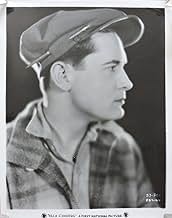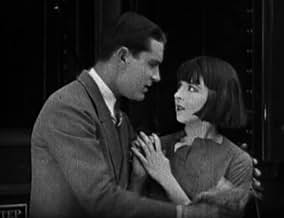AVALIAÇÃO DA IMDb
6,9/10
1,1 mil
SUA AVALIAÇÃO
Adicionar um enredo no seu idiomaElla Cinders, oppressed and abused by her stepmother and stepsisters, wins a contest for a film role in Hollywood. When the contest turns out to be fraudulent, she determines to stay and ach... Ler tudoElla Cinders, oppressed and abused by her stepmother and stepsisters, wins a contest for a film role in Hollywood. When the contest turns out to be fraudulent, she determines to stay and achieve Hollywood stardom the hard way.Ella Cinders, oppressed and abused by her stepmother and stepsisters, wins a contest for a film role in Hollywood. When the contest turns out to be fraudulent, she determines to stay and achieve Hollywood stardom the hard way.
- Prêmios
- 1 vitória no total
John D. Bloss
- Child Entering Movie Studio
- (não creditado)
Billy Butts
- Neighbor Kid
- (não creditado)
E.H. Calvert
- Studio Actor
- (não creditado)
Madalynne Field
- Fat Girl
- (não creditado)
Wendell Phillips Franklin
- Union Ice Wagon Driver
- (não creditado)
Russell Hopton
- Studio Actor
- (não creditado)
Audrey Howell
- Child Entering Movie Studio
- (não creditado)
Enredo
Você sabia?
- Erros de gravaçãoWhen Ella takes the taxi to the movie lot, the sign on the gate says "Gem Studio." When she approaches it, it now reads "Gem Film Company Now working in Egypt."
- ConexõesFeatured in Fractured Flickers: Allan Sherman (1963)
Avaliação em destaque
ELLA CINDERS (First National, 1926), a John McCormick production, directed by Alfred E. Green, is a star vehicle for Colleen Moore, a popular silent screen flapper of the 1920s, in one of her more notable comedies of her career that has become forgotten through the passage of time. It's a Hollywood story taken from both comic strip character and Cinderella fairy tale, and reminiscent to Mabel Normand performance in THE EXTRA GIRL (1923). Similarities in theme makes it quite easy to confuse these two, especially when both characters are seen disrupting the studio when encountered by a lion. While THE EXTRA GIRL switches to melodrama from time to time, ELLA CINDERS is pure comedy that makes good use of Moore's comedic talents.
Opening title card: "The Cinders residence in Roseville - where the first bowl of wax bananas appeared on an American sideboard." Ella Cinders (Colleen Moore) works like a slave for her wicked stepmother (Vera Lewis) and equally wicked stepsisters known as the Pills, Lotta (Doris Baker) and Prissy (Emily Gerdes), waiting on them hand and foot. Her one and only friend is Waite Lifter (Lloyd Hughes), a young man employed for the Union Ice Company, who in reality happens to be George Waite, a football hero and graduate from the University of Illinois as well as being the son of a millionaire (revealed on screen through a close up shot of a newspaper clipping)who disapproves of Ella. During a meeting of the Pollyanna Club held at the Cinders household every second Thursday of the month, where members get to "cheat at cards," Ella overhears her stepmother's intention on having Lotta representing Roseville by entering her in a movie contest sponsored by the Gem Film Company, with the prize being a trip to Hollywood and a chance to appear in a motion picture. Seeing this an opportunity in breaking away from the Pills, Ella earns the extra money needed for entrance fees and studio portrait taken of herself through babysitting. As she is poses to have her picture taken (one point being a strong resemblance of Lillian Gish), the photographer (Harry Allen) snapshots the very moment Ella becomes cross-eyed (like Ben Turpin) as she blows away a fly resting on her nose. It so happens that this is the picture that makes it to the judges. At the ball, where the winner's name is to be announced, to everyone's surprise, Ella's picture is the winner. After a merry send-off from the community (with the exception of the Pills) at the train station where the mayor (Jed Prouty) makes a speech, Ella takes off for Hollywood. Upon her arrival, she taxis over to the studio to find the Gem Film Company shut down and told by a guard that the contest was a scam and the "sharpies" arrested. Now stranded in the land of make-believe, and refusing to go back home in fear of being a laughing stock, Ella makes the best of her situation by "haunting the studio gates," sneaking past the guards and being chased around the lot, disrupting scenes currently in production and driving one of the directors (Alfred E. Green) out of his mind. With much more to follow, it gets better than this. Stay tuned and see what further develops for this Hollywood Cinderella.
Amusing at times as it is familiar, ELLA CINDERS, if remembered at all, has all the ingredients for surefire material in the Betty Hutton or Lucille Ball tradition. Funniest scene comes early in the story where Ella studies the method of acting from "The Art of Motion Picture Book," going through the motions with her eyes. An excellent use of special effects done in split screen, her eyes move individually in all directions. This scene alone was certainly one that had audiences laughing out of their seats back in 1926. This is followed by another set in the California bound train where Ella falls asleep, with all passengers getting off and to be awaken later surrounded by Indians, actually actors dressed as Indians who had come on at an earlier stop, being lead to believe the train was attacked. She becomes ill after smoking a cigar offered to her by an "Indian chief." Another highlight is the unbilled guest appearance of comedian Harry Langdon whom Ella mistakes as a wanna-be actor avoiding capture from the studio guards. "There's after me, too," she tells Langdon as he holds on to the door during a movie rehearsal.
Of a handful of Colleen Moore features produced during the silent era, ELLA CINDERS is best known due to availability on video cassette from various distributors and sporadic television revivals some decades ago, notably on the weekly public television series "The Toy That Grew Up," from the 1960s, complete with composed organ score, the same one used for the Grapevine Video Company with the running time of 70 minutes. While prints of ELLA CINDERS is in need of restoration, average or not so good prints in circulation don't deprive silent movie lovers from enjoying the misadventures of Miss Ella Cinders. (***)
Opening title card: "The Cinders residence in Roseville - where the first bowl of wax bananas appeared on an American sideboard." Ella Cinders (Colleen Moore) works like a slave for her wicked stepmother (Vera Lewis) and equally wicked stepsisters known as the Pills, Lotta (Doris Baker) and Prissy (Emily Gerdes), waiting on them hand and foot. Her one and only friend is Waite Lifter (Lloyd Hughes), a young man employed for the Union Ice Company, who in reality happens to be George Waite, a football hero and graduate from the University of Illinois as well as being the son of a millionaire (revealed on screen through a close up shot of a newspaper clipping)who disapproves of Ella. During a meeting of the Pollyanna Club held at the Cinders household every second Thursday of the month, where members get to "cheat at cards," Ella overhears her stepmother's intention on having Lotta representing Roseville by entering her in a movie contest sponsored by the Gem Film Company, with the prize being a trip to Hollywood and a chance to appear in a motion picture. Seeing this an opportunity in breaking away from the Pills, Ella earns the extra money needed for entrance fees and studio portrait taken of herself through babysitting. As she is poses to have her picture taken (one point being a strong resemblance of Lillian Gish), the photographer (Harry Allen) snapshots the very moment Ella becomes cross-eyed (like Ben Turpin) as she blows away a fly resting on her nose. It so happens that this is the picture that makes it to the judges. At the ball, where the winner's name is to be announced, to everyone's surprise, Ella's picture is the winner. After a merry send-off from the community (with the exception of the Pills) at the train station where the mayor (Jed Prouty) makes a speech, Ella takes off for Hollywood. Upon her arrival, she taxis over to the studio to find the Gem Film Company shut down and told by a guard that the contest was a scam and the "sharpies" arrested. Now stranded in the land of make-believe, and refusing to go back home in fear of being a laughing stock, Ella makes the best of her situation by "haunting the studio gates," sneaking past the guards and being chased around the lot, disrupting scenes currently in production and driving one of the directors (Alfred E. Green) out of his mind. With much more to follow, it gets better than this. Stay tuned and see what further develops for this Hollywood Cinderella.
Amusing at times as it is familiar, ELLA CINDERS, if remembered at all, has all the ingredients for surefire material in the Betty Hutton or Lucille Ball tradition. Funniest scene comes early in the story where Ella studies the method of acting from "The Art of Motion Picture Book," going through the motions with her eyes. An excellent use of special effects done in split screen, her eyes move individually in all directions. This scene alone was certainly one that had audiences laughing out of their seats back in 1926. This is followed by another set in the California bound train where Ella falls asleep, with all passengers getting off and to be awaken later surrounded by Indians, actually actors dressed as Indians who had come on at an earlier stop, being lead to believe the train was attacked. She becomes ill after smoking a cigar offered to her by an "Indian chief." Another highlight is the unbilled guest appearance of comedian Harry Langdon whom Ella mistakes as a wanna-be actor avoiding capture from the studio guards. "There's after me, too," she tells Langdon as he holds on to the door during a movie rehearsal.
Of a handful of Colleen Moore features produced during the silent era, ELLA CINDERS is best known due to availability on video cassette from various distributors and sporadic television revivals some decades ago, notably on the weekly public television series "The Toy That Grew Up," from the 1960s, complete with composed organ score, the same one used for the Grapevine Video Company with the running time of 70 minutes. While prints of ELLA CINDERS is in need of restoration, average or not so good prints in circulation don't deprive silent movie lovers from enjoying the misadventures of Miss Ella Cinders. (***)
- lugonian
- 27 de ago. de 2006
- Link permanente
Principais escolhas
Faça login para avaliar e ver a lista de recomendações personalizadas
Detalhes
- Tempo de duração1 hora 15 minutos
- Mixagem de som
- Proporção
- 1.33 : 1
Contribua para esta página
Sugerir uma alteração ou adicionar conteúdo ausente

Principal brecha
By what name was O Prêmio de Beleza (1926) officially released in Canada in English?
Responda






























